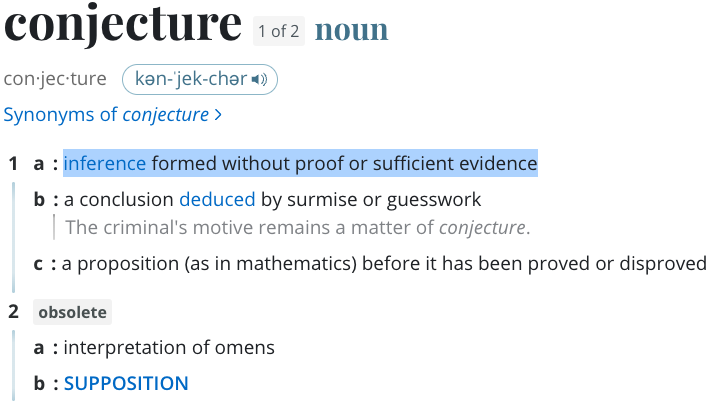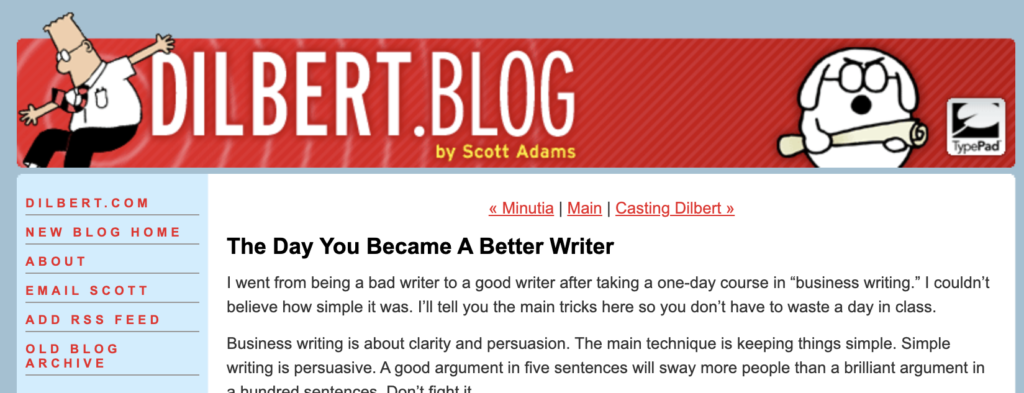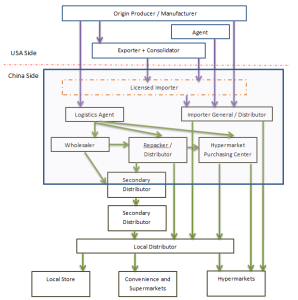an inference (conclusion) formed without sufficient evidence


Work to Produce & Live to Thrive
[this was generated by AI using https://app.myjotbot.com/ }
When it comes to training a golden retriever, many individuals opt for traditional methods such as positive reinforcement and rewards-based training. While these techniques can be effective, they often take a considerable amount of time and effort. This is where prong collars come in. Despite their controversial reputation, prong collars have been proven to be a safe and effective training tool for a golden retriever. In fact, there are four distinct benefits that make them worth considering: improved obedience, reduced stress, shorter training time, and quick results. Let’s dive into each of these benefits to see how they can make the training process more efficient and ultimately lead to better behavior in your furry companion.
One of the key benefits of using prong collars for training a golden retriever is improved obedience. The prongs on the collar act as a communication tool between a dog and their owner, mimicking their mother’s natural correction. This type of correction is gentle and effective, making it an ideal training method for a golden retriever. Additionally, prong collars are designed to be a tool used in conjunction with other forms of training, such as positive reinforcement, not a replacement. By combining these techniques, pet owners can see fantastic results with a well-behaved and obedient pet.
In conclusion, while there are varying opinions on the use of prong collars, their benefits cannot be denied. By using prong collars in conjunction with positive reinforcement, pet owners can see quick results leading to an obedient and well-behaved golden retriever. Not only can prong collars reduce stress and shorten training time, but they can also provide a safe and effective way to communicate with your pet. When considering training methods for your pet, prong collars should certainly be an option to consider.
In the ever-evolving landscape of business, digital transformation has emerged as a crucial strategy for organizations aiming to stay competitive and relevant. However, the journey towards a successful digital transformation is multifaceted and requires careful planning, strategic execution, and adaptability. In this comprehensive guide, we delve into the key elements and best practices that organizations can leverage to ensure a successful digital transformation.
1. Establishing a Clear Vision and Strategy:
2. Leadership Commitment and Engagement:
3. Building a Cross-Functional Team:
4. Investing in the Right Technologies:
5. Data-Driven Decision-Making:
6. Customer-Centric Approach:
7. Agile Methodology:
8. Change Management:
9. Cybersecurity Measures:
10. Measuring and Monitoring Progress:
11. Adaptability and Flexibility:
12. Strategic Partnerships and Collaborations:
Conclusion: achieving a successful digital transformation is a multifaceted endeavor that requires a strategic vision, leadership commitment, and a comprehensive approach to technology adoption. By following these best practices, organizations can navigate the complexities of digital transformation. And emerge technologically advanced but also more agile, customer-focused, and well-positioned for future
Change is inevitable, and in the dynamic landscape of business, organizations must navigate transitions effectively to thrive. Change management is a critical aspect of this process, ensuring that individuals, teams, and the organization as a whole adapt smoothly to new initiatives. Here, we delve into the best practices around change management, providing insights into strategies that facilitate a seamless transition.
1. Clear Communication:
2. Leadership Involvement and Support:
3. Associate Involvement:
4. Thorough Planning:
5. Cultural Assessment and Alignment:
6. Feedback Mechanisms:
7. Recognition and Celebration:
8. Technology Integration:
9. Sustainment and Continuous Improvement:
10. Measuring Success:
Effective change management is a multifaceted process that requires careful planning, open communication, and a commitment to continuous improvement. By incorporating these best practices, organizations can navigate change with confidence, ensuring that their teams are not only resilient but also positioned for success in an ever-evolving business landscape.
In the dynamic realm of retail, brick-and-mortar stores are undergoing significant transformations in 2023. One prominent trend is the integration of technology to enhance the in-store experience. Augmented Reality (AR) and Virtual Reality (VR) applications are being deployed to engage customers, offering them immersive experiences that bridge the gap between the physical and digital worlds. Interactive displays and smart mirrors are becoming commonplace, allowing shoppers to visualize products in real-time. Moreover, artificial intelligence is revolutionizing inventory management and customer service, providing retailers with valuable insights into consumer behavior and preferences.
Another notable shift is the emphasis on sustainability and eco-conscious practices. As consumers increasingly prioritize environmentally friendly choices, retailers are adapting by adopting sustainable sourcing, reducing packaging waste, and implementing energy-efficient technologies. The eco-friendly focus extends beyond products to the design and construction of physical stores, with many retailers opting for green building practices and renewable energy sources.
The convergence of online and offline shopping experiences is a trend reshaping the landscape. Retailers are investing in omnichannel strategies to create a seamless journey for consumers, allowing them to transition effortlessly between online and in-store shopping. Click-and-collect services have gained momentum, providing customers with the convenience of online browsing and the immediacy of in-store pickup. The integration of mobile apps and e-commerce platforms with brick-and-mortar locations enhances personalization and facilitates a more connected shopping experience.
Furthermore, the concept of experiential retail is taking center stage. Beyond traditional transactions, consumers seek memorable experiences when they visit physical stores. Retailers are responding by transforming their spaces into immersive environments that offer more than just products. Pop-up events, workshops, and interactive installations create a sense of community and engagement, encouraging customers to view the store as a destination rather than a mere transaction point.
Adapting to changing consumer expectations, brick-and-mortar retailers are investing heavily in data analytics. Harnessing the power of big data enables businesses to gain insights into customer preferences, buying patterns, and overall market trends. This data-driven approach not only informs inventory management but also facilitates targeted marketing strategies. Personalized promotions, loyalty programs, and tailored recommendations are becoming increasingly prevalent, enhancing the overall customer experience.
In response to the rise of e-commerce giants, many brick-and-mortar retailers are exploring collaborations and partnerships to strengthen their competitive position. Strategic alliances with online platforms and local businesses are fostering innovative approaches to customer acquisition and retention. Joint marketing efforts and shared loyalty programs create a symbiotic relationship that leverages the strengths of both online and offline retail.
While the digital landscape continues to evolve, brick-and-mortar retail is far from obsolete. The trends in 2023 reflect a dynamic industry that is embracing change and leveraging technology to meet the evolving needs of consumers. By blending the physical and digital realms, prioritizing sustainability, creating memorable experiences, and harnessing the power of data, brick-and-mortar retailers are not only surviving but thriving in the ever-evolving retail landscape.
First Understand the Role of an Account Manager
Key Skills for Successful Account Management:
Strategies for Successful Account Management:
Internal Teams:
Continuous Improvement & Professional Development:
(bullets, deadlines, proofread)
Throughout the coming months my intention is to dedicate some time to practice writing. Better said, the goal is to just write more and publish here as a form of light accountability. The expectation is that on the other side of this proposed period of time, the quality of the output is higher than current. I have decided to set Scott Adams’ well known post as my guiding north star in these exercises.


Unfortunately there is nothing “new” that can be written, there can only be small twists or combinations of the following core plots…
https://en.wikipedia.org/wiki/The_Thirty-Six_Dramatic_Situations
Geo question came up, which is larger by size: Venezuela or Ukraine? Venezuela won with 916,000km2 (population 33M), Ukraine 603,000km2 (~45M population). Thinking about the relative size of Africa and the infographic that came out on social networks some time ago, became curious about the land mass of the different continents and countries. A quick list below with rounded rough numbers
| Asia | 45 | million km2 |
| Africa | 30 | million km2 |
| North America | 25 | million km2 |
| South America | 18 | million km2 |
| Europe | 10 | million km2 |
| USA | 10 | million km2 |
| Australia | 8 | million km2 |
| Russia | 17 | million km2 |
| Canada | 10 | million km2 |
| China | 10 | million km2 |
I am regularly asked what is the status of the relationship between US and Venezuela. Depending on the level of foreign affairs knowledge of the audience I answer a little differently, but I do add that through the diplomatic dialogue and media statements AND sanctions imposed by the US, the oil trade continues without skipping a beat and that Venezuela is one of the top sources of US’s imported petroleum products. The full list is here but the top of the list of sources of imported (ignoring domestic production completely for now) petroleum products (mostly crude) are:
| Total | ~9MM bbl/d |
| Canada | 37% |
| Saudia Arabia | 13% |
| Mexico | 9% |
| Venezuela | 9% |
| Russia | 4% |
May be interesting for some to see that the US does plenty of business with “bad” countries as well, just does not advertise its activities.
I was curious about the upcoming Olympic games, then challenged myself to fill in as many of the recent two decades of games’ locations. Failed at that miserably and referenced the rest of the locations for a complete list.
| Summer | YEAR | Winter |
|---|---|---|
| 2022 | Beijing | |
| Tokyo | 2020 | |
| 2018 | South Korea | |
| Rio | 2016 | |
| 2014 | Sochi | |
| London | 2012 | |
| 2010 | Vancouver | |
| Beijing | 2008 | |
| 2006 | Turin | |
| Athens | 2004 | |
| 2002 | Salt Lake City | |
| Sydney | 2000 | |
| 1998 | Nagano | |
| Atlanta | 1996 | |
| 1994 | Lillehammer | |
| Barcelona | 1992 | Albertsville FR |
| Seoul | 1988 | Calgary |
| Los Angeles | 1984 | Sarajevo |
| Moscow | 1980 | Lake Placid |
| Montreal | 1976 | Innsbruck |
| Munich | 1972 | Sapporo |
| Mexico City | 1968 | Grenoble FR |
| Tokyo | 1964 | Innsbruck |
| Rome | 1960 | Squaw Valley |
| Melbourne+ Stockholm | 1956 | Italy |
| Helsinki | 1952 | Oslo |
| London | 1948 | St. Moritz |
| war | 1944 | war |
| war | 1940 | war |
| Berlin | 1936 | Germany |
| Los Angeles | 1932 | Lake Placid |
| Amsterdam | 1928 | St. Moritz |
| Paris | 1924 | Chamonix |
| Antwerp | 1920 | --- |
| war | 1916 | --- |
| Stockholm | 1912 | --- |
| London | 1908 | --- |
| St. Louis | 1904 | --- |
| Paris | 1900 | --- |
| Athens | 1896 | --- |
Ask the person to repeat back the information
1. Prepare before delegating
2. Specifically and clearly define the task
3. Clearly outline the time frame
4. Define the level of authority to use with this task
Level 1: Authority to Recommend
Level 2: Authority to Inform and Initiate
Level 3: Authority to Act
5. Identify Checkpoints to Review Progress
From more frequent to more sparse as quality improves
6. Debrief
What went well
What can be improved
What has been learned
Taken back in 2009 from If You Want It Done Right, You Don’t Have to Do It Yourself by Donna Genett; this list shared with Mark Weber as a tool and guideline for empowering the AMs. <edit: forgot that I wrote about this many years ago>
| A 12-15 months old heifer (or mature cow) |
| impregnated by a bull or though AI |
| after a 9 month (280-285 days) gestation period (pregnancy) |
| creates a 70-100lb calf |
| 6-8 months on a farm with the mother |
| creates a 500-600lb calf |
| which is purchased at around $1,000USD |
| 6-8 months in the feedlot |
| eating 1.5%-2.5% of body weight daily |
| 20-30lbs of feed a day |
| creates a 1200-1300lb animal. |
| 60%-62% of the animal weight yields a fridge carcass |
| a carcass weight of 730-820lbs |
| bones are 20% of the carcasss weight |
| and 350-400 boneless meat from the carcass |
| which is 30%-35% of the live animal weight |
| and the rest is fat trimmings. |
| 30% is Chuck |
| 22% is Round |
| 21% is Loin |
| 11% is Rib |
| 7% is Short Plate |
| 5% is Brisket |
| 3% is Flank |
| 1% is Shank |
| Beef graded by USDA: |
| 2% is Prime |
| 5% is Choice (moderate) |
| 14% is Choice (modest) |
| 34% is Choice (small) |
| Select |
| Standard |
| Commercial |
| Utility* |
| Cutter* |
| Canner* |
From the highly praised classic by Robert Cialdini PhD ‘Influence: The Psychology of Persuasion‘ Just as applied economics is gripping, books on applied psychology are fascinating and can be highly valuable.
surveyed 913 middle- and upper-class urban Chinese aged 18 to 50, of whom 43% lived in Shanghai, 60% were men, and 45% earned more than ¥10,000 (£1,025) per month.
….when it came to prompted knowledge of wine regions, Bordeaux came out on top, with 87% of those surveyed saying they were aware of the appellation, followed by Provence (60%), Napa (57%) and then the Barossa (54%).
http://www.thedrinksbusiness.com/2013/11/sub-25-bordeaux-cab-quintessential-wine-in-china/
I am constantly asked to list off my top movie, or a top 5 list. It’s very tough to rank some films above others accounting for different segmentation. Here is a list of top 25 that I relatively quickly pieced together. Side note: when guessing the year of the film I guesses 10 exactly correct and on average for the 25 was off by 1.1 years.
Table is sortable.
| FILM | YEAR | DIRECTOR |
|---|---|---|
| North By Northwest | 1959 | Alfred Hitchcock |
| Vertigo | 1958 | Alfred Hitchcock |
| The Godfather | 1972 | Francis Ford Coppola |
| Heat | 1995 | Michael Mann |
| The Lives of Others | 2006 | Florian Henckel von Donnersmarck |
| Casablanca | 1942 | Michael Curtiz |
| High and Low | 1963 | Akira Kurosawa |
| Burnt by the Sun | 1994 | Nikita Mikhalkov |
| Scent of a Woman | 1992 | Martin Brest |
| The Usual Suspects | 1995 | Bryan Singer |
| The Aviator | 2004 | Martin Scorsese |
| Volver | 2006 | Pedro Almodovar |
| Catch me if You Can | 2002 | Steven Spielberg |
| Last of the Mohicans | 1992 | Michael Mann |
| Belle Epoque | 1992 | Fernando Trueba |
| From Here to Eternity | 1953 | Fred Zinnemann |
| LA Confidential | 1997 | Curtis Hanson |
| Todo Sobre Mi Madre | 1999 | Pedro Almodovar |
| Hable Con Ella | 2002 | Pedro Almodovar |
| Sabrina | 1995 | Sydney Pollack |
| Walking the Streets of Moscow | 1964 | Georgiy Daneliya |
| The English Patient | 1996 | Anthony Minghella |
| The Philadelphia Story | 1940 | George Cukor |
| East/West | 1999 | Regis Wargnier |
| Stealing Beauty | 1996 | Bernardo Bertolucci |
This is an excellent visual of how products entering China flow through multiple ownership. Good for understanding where markup originates and why some imported products (such as wine) is a multiple of the price in the source country, take a look at these who could be in play withing the supply chain.